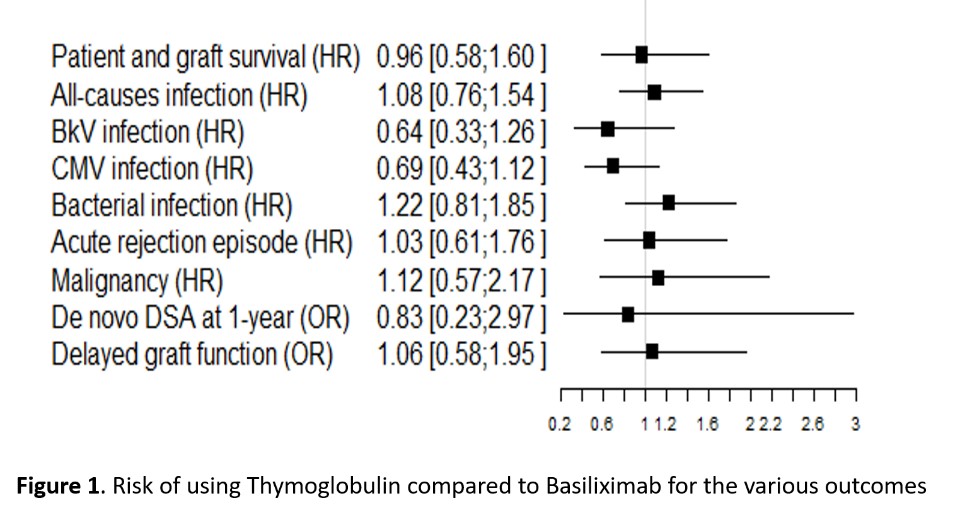Induction Therapy in Elderly Kidney Transplant Recipients with Low Immunological Risk
1University Hospital of Nantes, Nantes, France, 2University of Nantes, Nantes, France, 3University Hospital of Montpellier, Montpellier, France, 4University Hospital of Nancy, Nancy, France, 5University Hospital of Lyon, Lyon, France, 6University Hospital of Nice, Nice, France
Meeting: 2019 American Transplant Congress
Abstract number: B189
Keywords: Graft survival, Induction therapy, Infection
Session Information
Session Name: Poster Session B: Kidney Immunosuppression: Induction Therapy
Session Type: Poster Session
Date: Sunday, June 2, 2019
Session Time: 6:00pm-7:00pm
 Presentation Time: 6:00pm-7:00pm
Presentation Time: 6:00pm-7:00pm
Location: Hall C & D
*Purpose: Thymoglobulin (ATG) and Basiliximab (BSX) lead to similar rejection rates in low immunological risk patients. ATG seems to be associated with infectious and malignancy risk but could be benefit on Delayed Graft Function (DGF) and corticosteroid withdrawal.
*Methods: We compared patient and allograft survival in elderly recipients with low immunological risk according to the induction therapy. We conducted a French Multicentric study on non-immunized ≥ 65 years old patients receiving a first kidney transplant between 2010 and 2017 and an induction therapy by ATG or BSX. The principal outcome was patient and graft survival. We also studied the cumulative probabilities of infection, first acute rejection episode, malignancy; eGFR and occurrence of DGF at 1-year post transplantation. We estimated the impact of treatments after weighted the models on propensity scores.
*Results: 383 patients were studied: 204 in the BSX group (53.3%) and 179 in the ATG group (46.7%). Average age was respectively 71 and 70,5 years. Patient and graft survival at 3 years post-transplantation were 74% (95%CI from 65% to 84%) in the ATG group, and 68% (95%CI from 60% to 78%) in the BSX group. The corresponding HR (Hazard Ratio) equalled 0.96 between the BSX group compared to the ATG group (95%CI from 0.58 to 1.60). The probability of infection at 1-year post-transplantation were 52% (95%CI from 59% to 44%) in the BSX group versus 51% (95%CI from 59% to 42%) in the ATG group, without significant difference. There was no difference in all the others evaluated outcomes as indicated in Figure 1.
*Conclusions: In elderly recipients, induction by ATG does not lead to poorer outcomes that by using BSX, and particularly we did not observe an increasing infectious risk.
To cite this abstract in AMA style:
Masset C, Boucquemont J, Garrigue V, Ladrière M, Buron F, Cassuto E, Foucher Y, Dantal J. Induction Therapy in Elderly Kidney Transplant Recipients with Low Immunological Risk [abstract]. Am J Transplant. 2019; 19 (suppl 3). https://atcmeetingabstracts.com/abstract/induction-therapy-in-elderly-kidney-transplant-recipients-with-low-immunological-risk/. Accessed December 21, 2025.« Back to 2019 American Transplant Congress

